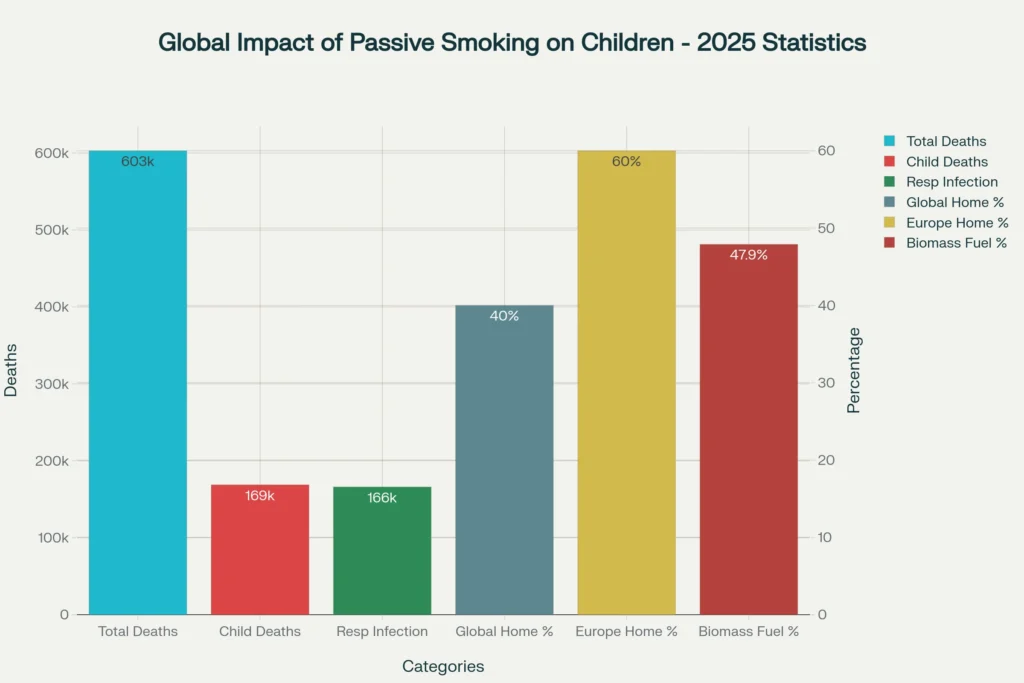Key Highlights:
- Passive smoking children face approximately 166,000 deaths annually from respiratory infections globally
- Children exposed to secondhand smoke experience a 20% increased risk of developing asthma
- Over 40% of children worldwide are regularly exposed to secondhand smoke in their homes
Opening Overview
Passive smoking children represent one of the most preventable yet persistent threats to respiratory health worldwide. As World Lung Day 2025 emphasizes “Healthy Lungs, Healthy Life,” the Forum of International Respiratory Societies highlights the critical need to protect children from passive smoking exposure. Recent data reveal that passive smoking causes approximately 603,000 premature deaths annually, with 28% occurring in children, making it a leading cause of preventable pediatric mortality. Children’s developing respiratory systems make passive smoking particularly vulnerable to the toxic chemicals in secondhand smoke, which can cause immediate and long-term damage to lung function. The harmful effects of passive smoking children’s lungs extend far beyond temporary irritation, creating lasting impacts on respiratory health that can persist into adulthood.
The Growing Global Crisis Affecting
Passive smoking are affected across all socioeconomic levels, with alarming statistics showing that 47.9% of households globally use solid biomass fuels while exposing children to secondhand smoke. The World Health Organization estimates that secondhand smoke exposure contributes to over 1.2 million deaths annually worldwide. Recent studies indicate that passive smoking children living in households with clean fuel but exposed to secondhand smoke face a 19% higher risk of acute respiratory infections compared to those in smoke-free environments.
The prevalence of exposure varies significantly by region, with some European countries reporting that up to 60% of passive smoking are exposed to secondhand smoke at home. This widespread exposure underscores the urgent need for comprehensive strategies to protect passive smoking children’s respiratory health from the devastating effects.

Immediate Respiratory Damage
Passive smoking children experience immediate respiratory damage that can manifest within hours of exposure. The Centers for Disease Control and Prevention confirms that secondhand smoke exposure produces harmful inflammatory and respiratory effects within 60 minutes, lasting at least three hours after exposure. Passive smoking introduces over 4,000 toxic chemicals into children’s developing lungs, including formaldehyde, benzene, and carbon monoxide, which directly damage respiratory tissues. Research demonstrates that passive smoking children show significantly reduced lung function, with studies reporting a 9% reduction in FEV1 (forced expiratory volume) among exposed children compared to those in smoke-free environments.
The immediate effects in passive smoking children include increased airway resistance, heightened inflammatory responses, and compromised immune function in the respiratory system. These acute changes in lung function can trigger wheezing, coughing, and shortness of breath, symptoms that become increasingly common in passive smoking children with regular exposure.
Long-term Lung Function Impairment
The long-term consequences on passive smoking children’s lung development are profound and often irreversible. Studies tracking passive smoking over multiple years demonstrate that those exposed to secondhand smoke experience permanently reduced lung growth and lower attained lung function in adolescence. Passive smoking during critical developmental periods can result in smaller airways and reduced overall lung capacity in passive smoking children, effects that persist throughout life. Research involving 1,819 participants aged 8-17 years showed a clear dose-response relationship in passive smoking children, with decreased FEV1 and FVC measurements correlating directly with the number of household smokers.
The mechanisms behind this permanent damage in passive smoking children include chronic inflammatory reactions caused by irritants, enhanced airway resistance, and increased susceptibility to respiratory infections that further compromise lung development. Passive smoking children also face higher risks of developing chronic obstructive pulmonary disease (COPD) in adulthood, representing a lifelong burden from childhood exposure.
Asthma Development
Passive smoking serves as both a trigger for asthma development and an exacerbating factor for existing asthma in passive smoking. Meta-analysis research indicates that secondhand smoke exposure increases the incidence of asthma in passive smoking children and young adults by 20%, making it one of the most significant preventable risk factors for pediatric asthma. Passive smoking with pre-existing asthma experience more severe symptoms, increased frequency of attacks, and higher rates of hospitalization.
The relationship between secondhand smoke and asthma appears strongest in younger passive smoking children, with studies showing that the odds ratio for asthmatic wheeze decreases from 2.5 at one year of age to 1.2 at four years of age. Passive smoking triggers asthma attacks in passive smoking children through multiple mechanisms, including direct airway irritation, enhanced allergic responses, and increased sensitivity to other environmental triggers. The severity of asthma symptoms correlates directly with the level and duration of secondhand smoke exposure, with passive smoking children in homes where multiple family members smoke facing the highest risks.
Closing Assessment
The evidence overwhelmingly demonstrates that passive smoking poses a severe and preventable threat to children’s respiratory health, with effects ranging from immediate lung function impairment to lifelong respiratory complications in passive smoking children. As World Lung Day 2025 emphasizes the theme “Healthy Lungs, Healthy Life,” protecting passive smoking children from secondhand smoke exposure must remain a global health priority.
The scientific data clearly shows that there is no safe level of exposure for passive smoking , with even brief exposures causing measurable harm to developing respiratory systems. Comprehensive smoke-free policies, public education campaigns, and individual family commitments to maintaining smoke-free homes represent essential steps in safeguarding passive smoking children’s lung health. The growing recognition of this threat, combined with emerging concerns about secondhand exposure to e-cigarettes and heated tobacco products, demands immediate and sustained action to protect passive smoking from preventable respiratory disease.


